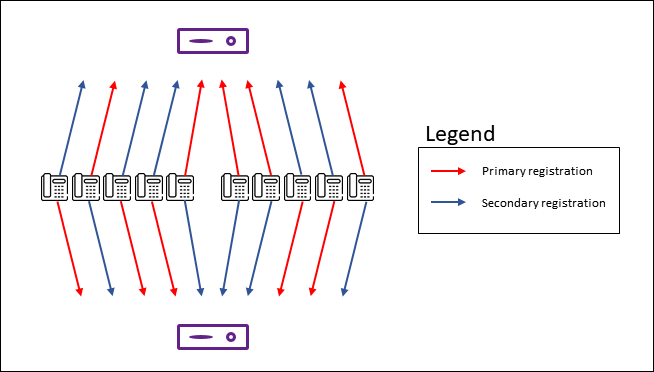BYOC Premises Edge redundancy
Regardless of whether you are using Genesys Hardware Solution (GHS) Edges or Customer Hardware Solution (CHS) Edges, Genesys recommends that you deploy your Edges in an N+1 configuration, where N is the number of premises-based Edges required to meet the expected maximum concurrent call load. This N+1 configuration ensures that you are able to place and receive both ACD and non-ACD calls if the active Edge fails or goes offline for routine maintenance.
In an N+1 configuration, managed phones register with both a primary and a secondary Edge. To spread out the load, Genesys Cloud randomizes each phone’s assignment of a primary and secondary Edge between the available premises-based Edges.
For example, suppose that you have two Edges and 10 phones. If so, then Genesys Cloud randomizes each phone’s primary and secondary registration between the two Edges, as illustrated in this diagram. In this case, each Edge has five primary registrations and five secondary registrations.

If the primary Edge is unreachable or offline, the phone switches to the secondary Edge to place and receive calls. The switch between the primary and secondary occurs almost immediately. However, it can take up to 15 seconds to place or receive calls with the Genesys Cloud user interface. This small time lag is due to the timing window required for the Edge-to-cloud heartbeat messages to resume.
To function correctly, Edge redundancy requires that you only combine Edges in a site that have a similar call capacity. For more information, see Concurrent call capacity for Edge models.
- You can combine any of the Genesys Hardware Solution – Edge GHS – Standards (v1, v2, and v3), including the Customer Hardware Solution – Large Edge, with each other.
- You can combine either of the
- Genesys Hardware Solution – Edge GHS – Minis (v1 and v2), including the Customer Hardware Solution – Small Edge, with each other.
- You can only combine the Edge GHS – Micro with other Edge GHS – Micros.
This BYOC Premises hardware combination matrix shows the acceptable combinations.
|
|
CHS – Large
|
GHS – Standard v3
|
GHS – Standard v2
|
GHS – Standard v1
|
CHS – Small
|
GHS – Mini v2
|
GHS – Mini v1
|
GHS – Micro
|
|---|---|---|---|---|---|---|---|---|
| CHS – Large |
|
|
|
|
||||
| GHS – Standard v3 |
|
|
|
|
||||
| GHS – Standard v2 |
|
|
|
|
||||
| GHS – Standard v1 |
|
|
|
|
||||
| CHS – Small |
|
|
|
|||||
| GHS – Mini v2 |
|
|
|
|||||
| GHS – Mini v1 |
|
|
|
|||||
| GHS – Micro |
|

